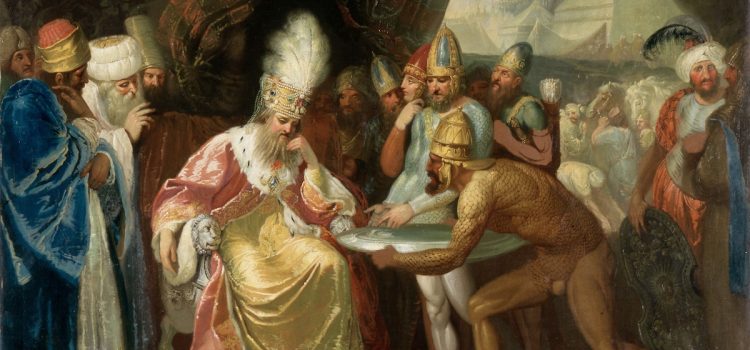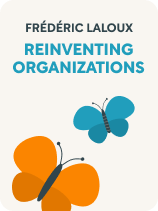

This article is an excerpt from the Shortform book guide to "Reinventing Organizations" by Frédéric Laloux. Shortform has the world's best summaries and analyses of books you should be reading.
Like this article? Sign up for a free trial here.
How have organizations changed over time? What accounts for these changes? Where are organizations headed next?
In order to understand the future shape of organizations, it’s important to look at how they’ve developed. In Reinventing Organizations, Frédéric Laloux traces a series of paradigm shifts in organizational structure over the past 10,000 years, arguing that each transition goes hand in hand with a change in how we think about the world.
Continue reading to understand the history of organizations from ancient kingdoms to modern corporations.
A History of Organizations
Laloux tracks the history of organizations from our nomadic forebears to modern-day companies and nonprofit groups that function as part of a wider, global whole, and he explains where he believes organizations are headed in the future.
(Shortform note: Other business experts recognize several more types of organizational structures than Laloux does, including functional structures, matrix structures, and network structures. Though technically more varied than the ones Laloux describes, the majority of structural options share a top-down chain of command.)
Laloux doesn’t imply that certain types of organizations are superior to others, only that certain stages embrace more complex worldviews. Each type of organization evolved to fill a niche and may still be the best option under certain circumstances. Laloux also makes it clear that each stage of development incorporates the advances that came before while making new breakthroughs that enhance how we work. Organizations commonly share aspects of several different paradigms at once, including traditional, modern, and inclusive structures.
(Shortform note: The evolution of human organizational structures mirrors the evolution of another important human feature: the brain. As new features developed in the brain over time, they encompassed the older evolutionary structures rather than supplanting them. Because the older structures in our brains serve vital functions, such as regulating autonomic functions or triggering our “fight or flight” response, they coexist with more recent evolutionary features, such as the neocortex.)
Laloux uses a color-code shorthand to denote the different organizational models (Amber, Orange, Green, and Teal). For clarity, we will instead use the terms traditional, modern, inclusive, and visionary.
Traditional Organizations
Since prehistory, humans have gathered into bands for mutual survival and protection. With the birth of agriculture and the end of humanity’s nomadic lifestyle came bureaucracies, organized religion, and the development of a fixed ruling class.
(Shortform note: Laloux actually lists three earlier paradigms before traditional organizations—nomadic family groups, larger tribal affiliations, and proto-kingdoms marked by one individual’s ability to dominate a collective by force. In this guide, we skip over these stages as they’re no longer functioning models except on the far outskirts of modern civilization.)
According to Laloux, these first formal organizations were rooted in strict hierarchical authority structures that maintained their power through tradition and adherence to collective norms. These traditional structures can still be found today in government agencies, militaries, religions, and schools.
(Shortform note: In The Dawn of Everything, David Graeber and David Wengrow challenge the idea that the development of formal human organizations coincided with the agricultural revolution; they find that it occurred much earlier. However, they agree with Laloux that hierarchical structures started to form within pre-agricultural nomadic tribes.)
Laloux writes that one key innovation of traditional organizations was that authority became invested in positions instead of persons and that rules were encoded into systems of laws. While these systems conferred ultimate authority upon one individual at the hierarchy’s peak, the will of that individual’s ego was subsumed into a collective “us vs. them” mentality. Belonging to the group was paramount, and individuals internalized the organization’s social norms.
The invention of agriculture also coincided with the invention of writing, which Laloux claims gave humanity a new concept of time that let us predict the future by studying patterns of the past. This development allowed for long-term planning, which reinforced the importance of tradition, but also made early organizations vulnerable in periods of unpredictable change. Tradition-based groups thrive best in times of stability, when rules are obeyed and no one deviates from their roles.
| The Cognitive Revolution In Sapiens, Yuval Noah Harari identifies an earlier shift in human development that Laloux skips over—the cognitive revolution that came about with the development of language. This revolution impacted our communal nature as a species by granting us the ability to create imagined realities and belief systems shared by whole groups. It’s this ability to create a communal narrative that Harari argues is vital for the establishment of lasting institutions. While agreeing with Laloux that these institutions enforce their rules through coercion, Harari states that without the shared narrative upon which an organization exists, there would be no common drive to maintain the institution. |
Modern Organizations
Because traditional organizations relied heavily on long-term stability and unquestioned authority, they faltered when the Scientific and Industrial Revolutions launched a period of accelerated change. Modern organizations developed, and they prized innovation over tradition, inquiry over dogma, and the merit of individuals over their preordained social class.
Laloux writes that fixed hierarchies of power were superseded by collective business enterprises, the precursors of modern corporations. Instead of trapping people in traditional roles, these new enterprises allowed them to question procedures and devise better ways of moving forward. The triumphs of this age include scientific progress and the freedom for people to choose their own purpose.
| The Pros and Cons of Modern Business Ironically, because modern organizational structures allow people to question established modes of operation, the benefits of corporate systems and free-market capitalism have themselves come under increasing fire in recent years. The long-standing argument from Nobel Prize winner Milton Friedman in Capitalism and Freedom is that economic and personal liberty go hand-in-hand, while rigid, authoritarian power structures act as a barrier to both. However, many people no longer accept this belief at face value. In The Shock Doctrine, Naomi Klein illustrates that free-wheeling capitalism and corporatism are themselves merely another form of unchecked hierarchical power, citing modern corporations’ disastrous impact when their values are forced upon different systems. |
Laloux notes that modern organizations retain a hierarchical structure, but, in the modern model, previously rigid barriers in class and status are less strict. Direction, goals, and objectives come from the top, but it’s those at the bottom who determine how those goals are put into practice.
(Shortform note: These principles can even appear in otherwise strongly traditional structures, such as military organizations. For example, in Superforecasting, Dan Gardner and Philip E. Tetlock cite the methods of the 19th-century Prussian commander Helmuth von Moltke. He trained his officers to think on their feet and question their orders, in direct opposition to other armies’ traditions, which relied on strict obedience and rote memorization of strategies.)
Laloux acknowledges that the innovations brought about by modern organizations are responsible for our current age of abundance, in which agriculture, healthcare, and leaps in technology allow our planet to support a population that would have been unthinkable in the past. However, modernity exacts a heavy toll in the form of greed and overconsumption.
(Shortform note: It’s not hard to take potshots at modern society. However, in Zero to One, Peter Thiel argues that progress is our only path forward, and that we should pursue advances that empower individuals and reduce the drain on our planet’s resources. Similarly, in Doughnut Economics, Kate Raworth underscores the problem of unchecked growth while advocating for a more democratic economy that prioritizes human happiness and prosperity.)
Inclusive Organizations
In response to the soulless nature of modern organizations, inclusive groups took root in the 1960s, following the model of prior centuries’ movements to expand human rights. Laloux claims that inclusive organizations break down traditional and modern power structures by emphasizing group consensus. These organizations made strides in empowering individuals and broadening our understanding of our impact on the world.
Whereas modern organizations’ obligations are to their shareholders, inclusive organizations have a wider scope of duty to their employees, their communities, and the environment. In inclusive organizations, many of which are nonprofit groups, those at the top are “servant leaders” whose role is to support those who work beneath them. Decisions are often based on the organization’s values and culture, which they place at the center of their communal identity.
| The Responsible Corporation The idea that business leaders serve those beneath them has gained much traction over the years. In The Leadership Challenge, James Kouzes and Barry Posner define leadership as a relationship dependent on the entirety of a team and contend that leaders are responsible for empowering others in their organizations. Likewise, the concept of “corporate social responsibility” is now touted as a beneficial model that not only serves the interests of society and the environment, but also provides value for traditional shareholders by increasing brand recognition, improving worker morale, and reducing the risk of legal action against the company. |
Laloux says that, while inclusive organizations subvert the power structures of tradition and modernity, they haven’t been successful at coming up with workable replacements. Being consensus-driven, they’re easily bogged down by their need to honor every point of view. Still, Laloux doesn’t see inclusive structures as a failure but rather as a necessary stepping stone to the next stage of humanity’s organizational development.
(Shortform note: Also referred to as the bottom-up business model, inclusive practices have been implemented at national newspapers and consulting firms. While Laloux suggests that employee-driven decision-making is the trend that will replace hierarchical leadership, business writer Mark Lukens says the choice is a false dichotomy—each approach can be valid in different situations, and leaders should adopt whichever works best at the moment.)
Visionary Organizations
Laloux dubs all previous structures as “ego-driven” organizations, whereas what follows is the beginning of a different kind of development. He predicts that next-level visionary organizations will see themselves as living things not beholden to the egos of individual members. The ongoing shift in human consciousness away from the ego-driven mindset will change how we and our organizations set priorities, deal with conflicts, and interact with the world. Future organizations may do this by placing a guiding purpose above concern for profit while emphasizing community and allowing their members to grow into their fully actualized selves.
(Shortform note: Other authors also see the importance of setting aside egos in organizations. In Ego Is the Enemy, Ryan Holiday argues that ego-driven ventures lead to failure more often than success. Holiday backs up Laloux’s assertion that a driving purpose is more valuable to individuals and society than satisfying the ego’s desire for power and recognition. Similarly, in The Infinite Game, Simon Sinek lists developing an idealistic institutional purpose as the first guiding principle for building a resilient business. A “just cause,” in Sinek’s words, provides a strong motivation for workers and buy-in from customers and clients. Staying true to such a purpose takes courage, because it often means prioritizing people over profit.)
Visionary organizations, according to Laloux, will merge the enlightened aspects of inclusivity with the practical savvy of modernity. They will be based on principles of self-management, with no structured hierarchy or push for group consensus. (Shortform note: The Covid-19 pandemic thrust self-management principles onto many industries by forcing companies to allow their staff to work without direct managerial supervision. By working from home, employees can be more productive while saving their companies money on technology, infrastructure, and facilities.)
In his research, Laloux studied 12 present-day organizations that model the attributes he believes will characterize this new type of organization. While he recognizes that his research lacks enough statistical power to draw firm conclusions, he believes his results suggest the path that future development may take. In the following sections, we’ll explore Laloux’s ideas about visionary organizations.
(Shortform note: In Built to Last, Jim Collins and Jerry I. Porras conduct a study similar to Laloux’s, but focusing on companies’ success and longevity rather than paradigm-shifting business practices. While their results agree with Laloux on some points, such as debunking the value of ego-driven leaders, they disagree on others, such as whether a successful business should feel like a safe space to be your authentic self. It should be noted that Collins and Porras use the word “visionary” differently than we do in this guide.)

———End of Preview———
Like what you just read? Read the rest of the world's best book summary and analysis of Frédéric Laloux's "Reinventing Organizations" at Shortform.
Here's what you'll find in our full Reinventing Organizations summary:
- The practices and values that are inherent in the next level of human organization
- A look at the paradigm shifts in organizational structure over the past 10,000 years
- How to implement visionary practices at your company






